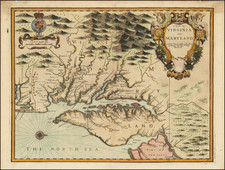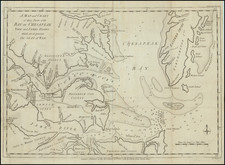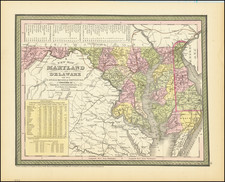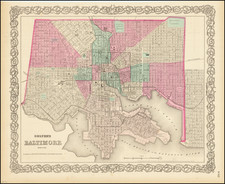Detailed city plan of Baltimore, showing streets, buildings, train lines, public places, rivers, etc.
The map includes the completed Baltimore and Ohio Railroad Company's Mount Clare Station. The Mount Clare Station was built in 1884 and was the headquarters of the Baltimore and Ohio Railroad Company, one of the oldest and most important railroads in the United States. The station was a major hub for rail traffic in the region and played a key role in the city's growing economy.
In the 1880s, Baltimore was a thriving industrial city, with active ports, growing population, and thriving economy, Baltimore was at the forefront of the nation's industrialization.
During the 1880s, Baltimore's economy continued to grow and prosper. The city's port was a major contributor to this growth, as it was a busy hub of trade and commerce. Baltimore's port imported goods from Europe and other parts of the world, and exported the products of the city's growing industries, including textiles, steel, and chemicals.
In addition to its port, Baltimore was also home to a thriving manufacturing industry. The city was known for its steel mills, which produced a wide range of products, including rails for the expanding railway system. The city was also home to many textile mills, which employed thousands of people and produced a wide range of textiles, including clothing, blankets, and towels.
In the 1880s, the city's population increased from around 350,000 to over 500,000, as people from across the United States and around the world flocked to the city in search of work and opportunities.
George F. Cram (1842-1928), or George Franklin Cram, was an American mapmaker and businessman. During the Civil War, Cram served under General William Tecumseh Sherman and participated in his March to the Sea. His letters of that time are now important sources for historians of the Civil War. In 1867, Cram and his uncle, Rufus Blanchard, began the company known by their names in Evanston, Illinois.
Two years later, Cram became sole proprietor and the company was henceforth known as George F. Cram Co. Specializing in atlases, Cram was one of the first American companies to publish a world atlas. One of their most famous products was the Unrivaled Atlas of the World, in print from the 1880s to the 1950s.
Cram died in 1928, seven years after he had merged the business with that of a customer, E.A. Peterson. The new company still bore Cram’s name. Four years later, the Cram Company began to make globes, a branch of the business that would continue until 2012, when the company ceased to operate. For the final several decades of the company’s existence it was controlled by the Douthit family, who sold it just before the company was shuttered.










![Maryland & Delaware and the District of Columbia [large Washington inset]](https://storage.googleapis.com/raremaps/img/small/100301.jpg)



